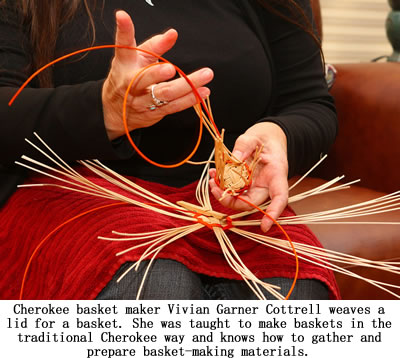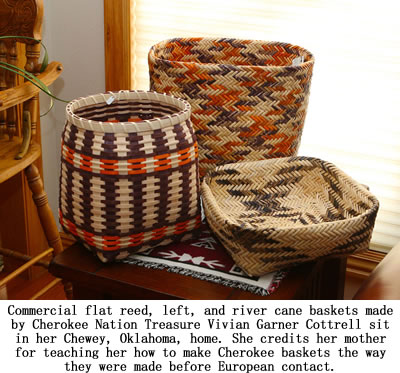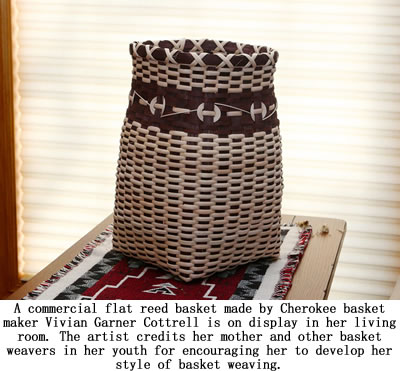 |
Canku Ota
|
 |
|
(Many Paths)
|
||
|
An Online Newsletter
Celebrating Native America
|
||
|
February 2015 - Volume
13 Number 2
|
||
|
|
||
|
Cottrell Carries
On Mother's Basket-Weaving Legacy
|
||
|
by Will Chavez -
Senior Reporter, Cherokee Phoenix
|
||
|
credits: All photos by
Will Chavez - Cherokee Phoenix
|
|
Chewey, OK – Basket weaver Vivian Garner Cottrell credits her mother for teaching her how to make Cherokee baskets the way they were made before European contact.
Cottrell has been weaving baskets since 1973 when she was in eighth grade. Her mother, Betty Scraper Garner, who was named a Cherokee National Treasure in 1993 for basketry, taught her how to make baskets using white oak splits and honeysuckle and buck brush "runners" or reed.
"We started out using commercial reed until my abilities became more developed, and then we started gathering honeysuckle and preparing it and dyeing it with the natural dyes – black walnut, different berries, wild cherry, mulberries and bois d'arc for the yellows," she said. "I didn't know back in the early (19)70s that it (Cherokee basket weaving) was almost gone. Over the years I've seen the numbers increase in weavers, which is good." She and her mom would gather honeysuckle runners, soak them in water and then pull each runner through a rough cleaning pad to remove the bark. After the runners dried, they would roll them and tie them until they needed the honeysuckle for weaving. Jobs were scarce when Cottrell was a teenager, so she said basket weaving was her job. "In the summer I would weave baskets and sell them to the gift shops. My mother would take me here and there and we would sell them. The price back then was between $5 and $7 or $10. If I had a lid on it, it was $15," she said. "I saved the money from the sale of my baskets. I bought my first car with my basket savings." She weaved with her mom for nearly 25 years. During that time, Cottrell was named a Cherokee National Treasure in 1995, two years before her mother's death. She also credits Cherokee National Treasure Mary Foreman, who was friend of her mother, for teaching her about baskets. "She (Foreman) always had a big pot (of honeysuckle) too going outside," she said. "Many teachers have gone on. I admired their works. What I took from that was that they were very supportive, and they would encourage me to develop my own style of weaving." Cottrell doesn't have as much time to weave these days because she and her husband travel across the state doing financial and compliance audits for cities, tribes and nonprofit entities. She is an accountant with a degree in business administration from Northeastern State University in Tahlequah. She still gathers and uses honeysuckle and prefers to use it, but because of her travels she uses commercial reed sold in hobby stores. Lately, she said, she's been gathering river cane along the Illinois River near her Chewey home. She strips off the cane's outer layer to use for baskets. "The only time I can weave is on weekends. As far as gathering and preparing and dying the natural materials, it's on the weekends," she said. The first few months of the year mean down time from work, so she has more time to go into the woods to gather and prepare materials and to weave, she said. Over the years she's won first place and second place ribbons at the annual Red Earth Native American Cultural Festival in Oklahoma City. She said she enjoys entering shows, but hasn't kept track of her awards. "I make one-of-a-kind baskets. I try not to make the same basket. Each one has it's own personality," she said. "I never considered myself a professional. I'm just a basket maker. I loved what I did with my mother." |
|||||
|
|
||
|
|
||
| Canku Ota is a free Newsletter celebrating Native America, its traditions and accomplishments . We do not provide subscriber or visitor names to anyone. Some articles presented in Canku Ota may contain copyright material. We have received appropriate permissions for republishing any articles. Material appearing here is distributed without profit or monetary gain to those who have expressed an interest. This is in accordance with Title 17 U.S.C. Section 107. | ||
|
Canku Ota is a copyright ©
2000 - 2014 of Vicki Williams Barry and Paul Barry.
|
||
 |
 |
|
|
The "Canku
Ota - A Newsletter Celebrating Native America" web site and
its design is the
|
||
|
Copyright ©
1999 - 2014 of Paul C. Barry.
|
||
|
All Rights Reserved.
|
||



